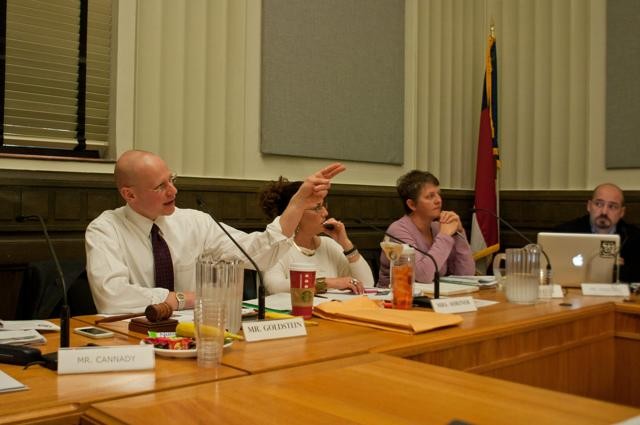After a discussion about conflicting city goals, the need for inreased density and the possibility of setting a precedent for growth throughout Asheville, the city's Planning and Zoning Commission narrowly approved a proposed 16-unit housing development on Chestnut Street at its Nov. 6 meeting.
The proposed development has been a flash point in larger debates about the sometimes-competing goals of alleviating the city's housing crunch and preserving neighborhood character [See “No Vacancy,” May 29 Xpress]. P&Z’s vote sends the project to Asheville City Council for final approval.
The small conference room on the first floor of City Hall was nearly full, with about 40 people observing the discussion. City staff supported the project, citing Council's stated goals of encouraging denser development downtown and near major corridors (the site is less than a block from Charlotte Street).
But approval came by a single vote after lengthy public comment — most of it from neighbors who criticized the design and density as out of place for the historic Chestnut Hill neighborhood.
"I left the bedside of my mother who had heart surgery because I feel this is an extremely important issue," said Jane Hart, a Baird Street resident. "There really isn't any element in this design I see that reflects anything historic. We're very genteel in nature. You just don't see a big block of concrete like this."
Some called it an "affront to the neighborhood” and said it would disrupt the existing social fabric. Others took issue with the design, which includes parking on the bottom floor of the main building, and said that its aesthetics are not in keeping with the sort appealing to tourists, unlike the nearby Princess Anne boutique hotel.
The Preservation Society of Asheville and Buncombe County, which has played a major role in marshaling resistance to the project, said that it instead favors "managed change" to "protect historic and traditional neighborhoods." Executive Director Jack Thomson told the board, "Neighborhoods thrive on the predictability of the surrounding environment. … It's very clear that a development on this site that followed the existing zoning classifications would still result in an increase of housing units." If the board turned down the developers’ request, Thomson asserted, they would instead build something more in keeping with the existing neighborhood.
Technically, the developers were requesting exceptions to the city's zoning rules that, they say, are necessary for the project to proceed. The proposal marks the first use of a density bonus that permits projects to exceed the normal number of units if the project creates denser, affordable housing to major corridors. In this case, four existing apartments on the site will become affordable housing once the larger project is completed.
According to architect Chad Roberson, the intricacies of the city's development rules meant that the requested exceptions were necessary for building a project that’s environmentally friendly, dense and includes affordable housing. He claimed that building a project to the critics’ specifications, within the existing zoning, would make it far more expensive for the developers and for future residents.
"The development pattern for the neighborhood is high-density," and the proposal is in keeping with that, he said, citing several nearby dense apartment complexes. "Affordable units are very difficult to do with what's allowed on the site."
Both opponents and supporters on the commission asserted that the project could set a precedent on how the city's larger development issues are addressed.
P&Z Chair Jeremy Goldstein said that the debate illustrated "a conflict of goals" between what elected officials have passed and what neighborhood residents say they want near their homes. "On the one hand we're charged with supporting the city's goal of affordable housing and promoting in-fill development while supporting green building; I'm hearing that the city wants us to increase density, especially in this area," he said. "Then I'm hearing a lot of comments [from the neighborhood residents] where they don't want that type of density. … That's my conundrum here; we're trying to adhere to two different things."
However, commission member Jane Mathews countered that the city's plans place equal emphasis on the preservation of neighborhood character. More urban-style development, she asserted, is better suited to downtown or the River Arts District, rather than in an "established neighborhood" like Chestnut Hill. "That tempers the decision-making we do," she said. "Development of these vacant lots has to offer opportunity without changing the character of the area; that's where the problem lies." She feared that approving this development will lead to a higher level of density in existing neighborhoods.
Fellow P&Z members Kristy Carter and Joe Minicozzi agreed, and also raised issues about the project’s design and the placement of parking.
But after the developer agreed to work with the owners of the adjoining, historic Patton-Parker House to create a larger buffer zone between it and the project, the commission approved the project 4-3. Mathews, Carter and Minicozzi voted against it.
As project opponents filtered out of the room, they promised that the development fight isn't over and talked about preparing to take their case to Council's chambers.




Before you comment
The comments section is here to provide a platform for civil dialogue on the issues we face together as a local community. Xpress is committed to offering this platform for all voices, but when the tone of the discussion gets nasty or strays off topic, we believe many people choose not to participate. Xpress editors are determined to moderate comments to ensure a constructive interchange is maintained. All comments judged not to be in keeping with the spirit of civil discourse will be removed and repeat violators will be banned. See here for our terms of service. Thank you for being part of this effort to promote respectful discussion.